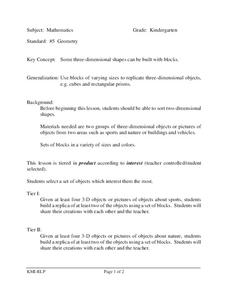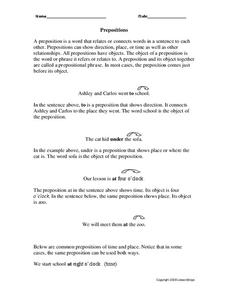College Board
AP® Computer Science: A Picture Lab Student Guide
How do you modify digital pictures? In this lab learners write methods that modify digital pictures. They how to traverse a two-dimensional array of integers or objects, and are introduced to nested loops, binary numbers,...
Research Parent
Solar System Cards
Find all things solar system in a set of reference cards. Even Pluto makes an appearance! Each of the 24 cards has a picture and accompanying informational text that gives brief background about the object.
National Nanotechnology Infrastructure Network
Understanding Wave Motion - Slinky vs. Snaky: Which Spring is Dominant?
Ride the wave to an understanding of refraction! The first in a series of two inquiry-based lessons challenges learners to create transverse waves with two different types of springs. As their wave hits an object, they observe the change...
Physics Classroom
Free Fall
Scholars must understand freefall before they learn how objects like airplanes fly. They apply knowledge of velocity and acceleration to predict speed and direction as part of a larger series on vectors and projectiles.
Curated OER
Transportation
Students read through an advertisement to explain meaning, and then present an advertisement they made to the class. They develop the uses of direct and indirect objects in Spanish
Curated OER
Max's Math Adventures
In this counting practice activity, students read the story rhyme about counting practice. Kids count a handful of objects they find in their home. Students then count the objects illustrated in each picture set. Students also draw six...
Curated OER
An Introduction to Collecting:
Students create webs about collecting and classify ideas into categories . Students develop rationales for collecting from an artist's perspective, Students collect and present objects based upon assigned criteria. Students compile...
Curated OER
Minerals and Rocks
Students identify and interpret various minerals and discover how to identify and classify them. They identify and discuss how people describe objects and how scientists describe objects. From there, students look at a set of common...
Curated OER
New Forms from Old
Learners look at historic porcelain objects. In this visual arts lesson, students examine how the use of historic objects has changed over time. Learners design their own object from paper cups, bowls, plates, and more.
Curated OER
Groundhog Sizes
Students use a variety of sizes of class poster groundhogs to order the objects by size. The groundhogs are replaced by a bag of objects and the sizing exercise continues.
Curated OER
Vocabulary & Language Development
Learners develop their vocabulary skills. In this vocabulary and language lesson plan, students practice naming everyday objects as they take part in 3 classroom activities that require them to note attributes of everyday objects their...
Curated OER
Geometry
Students build replicas about nature and sports. In this geometry lesson plan, students build 3D replicas of nature and sports objects in teams.
Curated OER
Everyday Marvels
Students consider the meaning of innovation and analyze the design of objects. In this object design lesson, students examine revolutionary objects and their design. Students complete discussion activities for objects like Band-Aids,...
Curated OER
Prepositions
In this prepositions worksheet, students identify prepositions and their objects in sentences. In this drawing lines and arrows worksheet, students identify prepositions and objects in ten sentences.
Curated OER
My Favorite Things
Learners identify "masterpieces" and mass-produced objects. They explain why they value a given object and determine what physical materials were used to create the objects. They create a class book featuring objects that they value.
Curated OER
Measuring Length and Width
Second graders practice measuring length and width of objects in inches. In this measurement lesson, 2nd graders use a ruler to measure the length and width of a chair, desk, and book. Students view a video, "Math Investigations II," to...
Curated OER
Magnify That
Students observe many different objects using a magnifying lens. In this magnification lesson plan, students learn that scientists use different tools, and they use the tool to magnify objects in the classroom to see objects in better...
Curated OER
Rockin' Rhythm Band
Students use ordinary objects to create rhythmic sounds and rhythms. They use such things as sandpaper, rubber bands, and pencils to follow teacher rhythms.
Curated OER
Sort it Out
Students identify and sort a variety of two- and three-dimensional objects and compare and contrast their attributes. They identify shapes, locate shapes on the faces of solids, sort real objects and explain the sorting rule, and...
Curated OER
Compile and Execute
Students are able to define the following terms: compiler, source code, object code, syntax code, and debugging. They are able to define a computational problem. Students are able to formulate a simple mathematical model. They are able...
Curated OER
Useful or Beautiful Worksheet
In this teaching and learning through objects worksheet, students determine whether they would choose to buy 10 items because they are useful or because they are beautiful based on a beauty /utility scale.
Curated OER
Types of Things
Students explore the differences between man-made and natural objects. In this lesson designed to compare properties of objects, students differentiate between natural and man-made objects and complete an activity designed to show what...
Curated OER
Marble Run
Students use marbles to conduct experiments on movement of objects and explore Newton's three laws of motion. In this motion lesson plan, students use marbles, tubing, foam, paper cups, and more.
Curated OER
Total English Intermediate: Getting the Question Right
For this subject and object questions worksheet, students correct the mistakes in 8 sentences and then write 8 complete subject/object questions in the second person.
Other popular searches
- Subject and Object Pronouns
- Classroom Objects
- Objectivity
- Direct Objects
- Object Pronouns
- Direct Object Pronoun
- Direct and Indirect Objects
- Object of the Preposition
- Classifying Objects
- Classify Objects
- School Objects
- Classroom Objects Bingo























